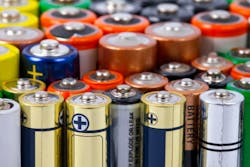While investigating a design for a rechargeable zinc-manganese dioxide battery, a team from the Pacific Northwest National Laboratory (PNNL) decided to bring out the “big guns”: advanced spectroscopy techniques that would enable them to observe the chemical reactions within the battery. This led to the discovery of why their manganese cathode could not repair itself during recharge—and a solution that could become an inexpensive and safer alternative to lithium-ion batteries. The results were published in a paper in the journal, Nature.
Rechargeable zinc-manganese-dioxide (Zn-MnO2) alkaline batteries are already on the market, but they can only be used for a few charge cycles. Due to an effect called electrode “sluff-off,” significant quantities of manganese ions do not make it back to the anode during recharging. Since these ions are necessary for oxidation of the anode during discharge, energy density decreases with every charge cycle. This same outcome was recorded when testing the design at PNNL, which consisted of a Zn cathode and MnO2 anode separated by an aqueous electrolyte.
To determine the root of the electrode sluff-off problem, the scientists performed transmission electron microscopy, nuclear magnetic resonance, and x-ray diffraction as the battery was in operation. The advanced tests showed an unexpected internal reaction in the Zn-MnO2 battery that further explained why portions of the manganese ions were not reuniting with the anode.
Comparing Zn-MnO2 to Lithium-Ion Batteries Was Erroneous
Before discovering the reversible reaction that was taking place between the manganese and the protons in the electrolyte, rechargeable Zn-MnO2 batteries were assumed to operate like lithium-ion batteries in a process called intercalation.
When looking at Li-ion batteries during discharge, lithium cations are formed as the lithium-graphite anode oxidizes to supply a flow of electrons to the load. The lithium ions are pulled from the anode and travel through the electrolyte. They pass a selectively permeable barrier and then, in a reversible intercalation process, they insert themselves between the molecules of the cathode. Meanwhile, the current flows through the circuit and back into the positive terminal of the battery, enabling the intercalated lithium ions to become neutralized via reduction of the cathode.
Similarly during charging, a load pulls electrons (current) from the cathode so that the lithium metal oxidizes again. The lithium ions transfer through the electrolyte back to the anode and reunite with electrons as they flow to the negative terminal. In the end, the lithium-ion battery is back to its original state for another cycle of usage.
The results of the spectrometry and microscopy for the Zn-MnO2 battery, on the other hand, showed a process that is much different than the reversible intercalation that occurs in Li-ion batteries. Instead of simply inserting themselves between molecules in the cathode, the tests showed that manganese ions were reacting with the protons in the electrolyte. They would then react with the zinc in the cathode to create zinc hydroxyl sulfate. This reaction at the cathode is irreversible, which means the next charge cycle would be significantly less effective.
To remedy this, the scientists simply added manganese ions to the electrolyte, keeping the reaction at equilibrium. Thus, a virtually equal quantity of manganese ions would reunite with the cathode. In their next round of testing, the battery with the manganese-enriched electrolyte performed over 5,000 cycles while retaining 92% of its initial storage capacity of 285 mAh.
About the Author
Leah Scully
Associate Content Producer
Leah Scully is a graduate of The College of New Jersey. She has a BS degree in Biomedical Engineering with a mechanical specialization. Leah is responsible for Machine Design’s news items that cover industry trends, research, and applied science and engineering, along with product galleries. Visit her on Facebook, or view her profile on LinkedIn.
